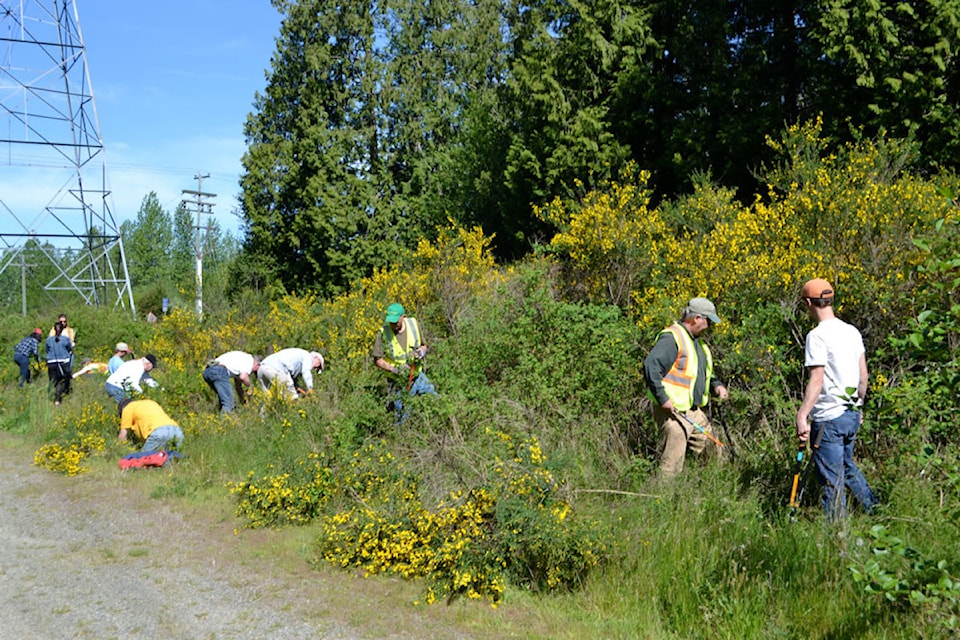This spring and early summer, signs that advocated for the control of Scotch broom appeared on the sides of roadways around Victoria. The message “Cut Broom in Bloom” was part of an ongoing battle that has now been waged for years on Vancouver Island.
So, what’s the problem with broom?
In short, the plant is a menace.
Lacking the natural controls that exist in its original habitats, Scotch broom has spread like wildfire to the point where it poses a litany of dangers, most notably the fact that it endangers the region’s native flora.
But that’s only one of the problems.
“The broom will certainly crowd out native species, but beyond losing those other plants, it also has a serious effect on the rest of the ecosystem,” said Gail Wallin, executive director of the Invasive Species Council of B.C. “All the insects and birds that rely on those ecosystems are also affected. Bees, for example will take advantage of the flowers on broom, but it’s a feast and famine situation where, once those blooms are gone, there are no other flowering plants left for the bees.”
According to Wallin, the broom infestations also pose a significant threat to the much-valued Garry oak ecosystems on the Island. It’s also toxic to livestock and can actually change the soil chemistry in infested areas.
But beyond the damage to the Vancouver Island's ecological balance, broom poses what some consider an equally serious threat that sometimes goes unrecognized.
“Broom has an incredibly high oil content and it’s a naturally dry wood so it’s a serious fire hazard,” said Janne Sales, executive director of Broombusters. “We just did about eight cuts through the Sooke parks department and there’s another group removing broom in East Sooke in conjunction with the CRD. But despite our efforts, broom is something you have to stay on top of.”
The problem is that Scotch broom is highly flammable and, when it spreads all along roadways or hydro rights-of-way, it provides the perfect highway of accelerant materials in a region where forest fires are already a serious concern.
“It certainly isn’t something you want anywhere near your home,” Sales said.
But the message is beginning to spread.
“In past years, we’ve had more than 600 volunteers out cutting broom. They probably put in more than 6,000 hours a year to try to control it.”
But control isn’t as easy as one might assume.
In the past, it was found that cutting broom with bush saws just didn’t work and that crews were actually spreading seeds so that, when they returned to the same area the following year, the infestation was worse.
“The best time to cut broom is when it’s in bloom and when most of its energy is being taken up with the flowering process,” said Wallin. “Then you have to remove those cuttings and dispose of them properly.”
But removal is still possible at other times of the year, so long as the cut plants are disposed of in dedicated areas.
Paul Henry, a broom-bashing volunteer with the Highland Community Association heads the community’s eradication program.
“What we do involves community education. In May, we have our ‘Broom Bash’ where people go out on their own and cut broom and then bring it to us to be disposed of,” said Henry. “I’ve been doing this for 10 years and I’ve seen some dramatic changes in the amount of broom."
The group has incentivized participation through raffles and prizes for the biggest broom pile and, during COVID, even traded big bundles of toilet paper for piles of broom.
“We’ll do whatever it takes to let people know how much of a danger this plant is.”
And yet, despite the fact that, according to the invasive species council of B.C., invasive species are responsible for tens of millions of dollars in damage, there are still some landscaping firms that continue to sell and promote invasive plants as landscaping material.
“We need to educate those businesses and people in general about the damage that they’re doing by continuing to use invasive plants,” Wallin said.
If only that education had existed back in 1850, when Captain Walter Colquhoun Grant, apparently homesick for Scotland, decided to plant the first Scotch broom on Vancouver Island.
“We certainly know better now … or at least we should know,” said Wallin.


